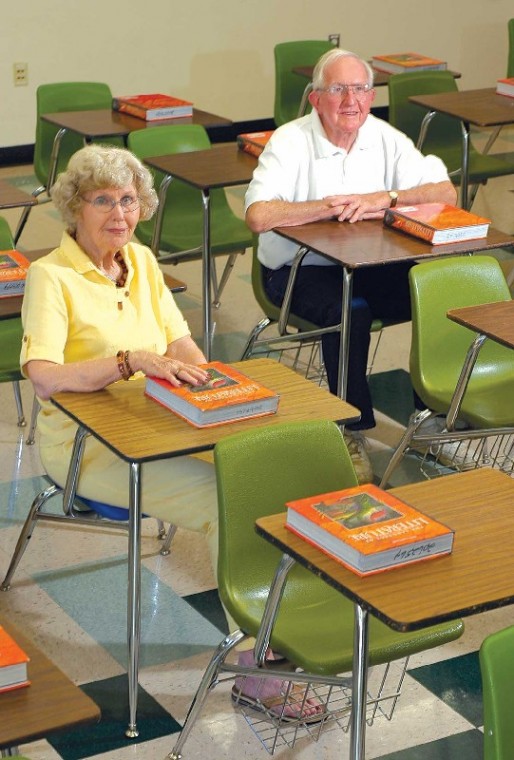The world was considerably different when Live Oak High School
first opened its doors to local students 100 years ago. Though
times have changed, the nutty spirit of Acorn graduates still
remains strong.
The world was considerably different when Live Oak High School first opened its doors to local students 100 years ago. Though times have changed, the nutty spirit of Acorn graduates still remains strong.
On Sunday, more than 250 alumni from the past 10 decades will gather at the school to share memories of their days as students and celebrate the school’s centennial with family and friends.
And while many alumni have likely forgotten the lessons taught in the school’s hallowed halls, they will always have the memories of being an Acorn.
“We didn’t even have a telephone when I first started at Live Oak, and then when we did get one, it was long distance to call San Martin,” said Elena Moreno, Class of 1939. “We went to school plays and musical concerts in the gymnasium. There wasn’t a football team, but we did have some basketball games to go to.”
Moreno said during her years as an Acorn, she lived on a ranch in what is now Coyote Valley. Much of her activities were centered on the ranch.
“Almost all of us were from orchards,” she said. “We worked all summer picking apricots, picking for others, moving around to the different orchards. We didn’t mind; you can talk while you’re picking apricots.”
John Ward, Class of 1946, shares similar memories of his high school alma mater.
“It was a little different for kids living in the country than living in the city,” Ward said. “The population was not very abundant out here. We usually came home, and we had homework. There were really no after-school activities. We would have a school dance, some basketball games to attend.”
The auditorium where school plays and concerts were held had not been built when Moreno was a student. The auditorium, which is the current auditorium for Britton Middle School, was “fairly new” when Ward attended, he said. The main school building was on the current Britton campus where the tennis courts are now.
Although activities were limited compared to what students can participate in now at Live Oak, both Ward and Moreno said they didn’t feel they had missed anything.
“It’s extremely different now, what the school has to offer, but what I remember was having a wonderful experience,” Ward said. “The teachers were wonderful, they made a lasting impression on us as students. We had a very good music program. I was involved all four years. And I took art.”
Ward, who played violin in high school, said he later taught art, though not in Morgan Hill.
Moreno also taught later in life, and said her interest in the profession came from her experience as a student. She said her mother also attended Live Oak, driving to the school in a horse and buggy from “way out by Anderson Dam, though it wasn’t a dam then.”
One of the things she remembers from her high school experience is the day when almost the entire student body skipped school to go see the “lake” that had formed north of town.
“They had just constructed the railroad pass (at Monterey Road and Old Monterey Road), and there was a very heavy rainstorm, and it filled up overnight,” she said. “Everyone went to go see the lake in Morgan Hill. I didn’t go, but nearly everyone else did. It was so bad, buses had to be re-routed and all traffic from San Francisco to Los Angeles.”
Another incident that made a big impression on Moreno was the junior prom.
“There were two formal events each year, formal meeting gown to the floor: the freshman reception and the prom for juniors,” she said. “When I was a sophomore, I was invited to the prom by a junior, but my father wouldn’t let me go. I wasn’t doing a lot of dating at the time.”
When Ward was a student, there were more dances during the year, but not necessarily formal, he said.
“That was our main form of entertainment, aside from the occasional basketball game,” he said. “The war was on for most of those years, and the school wanted to let the young people that were there enjoy themselves. Sometimes we wondered what’s going to happen after high school, because of the war, but generally it felt far away from Morgan Hill.”
The war felt closer with the completion of the auditorium because officials chose to dedicate it to the fallen soldiers of World War II. A plaque in the auditorium includes Charles Raney, the great-uncle of Pamala Meador, Class of 1975.
The roots of Live Oak run deep through Meador’s family: her grandmother, Mary Raney, graduated in 1925 and her mother in 1954. Her parents first met at Live Oak and her sister, two brothers, two nieces and two nephews all are alumni. She also has three great-uncles and one great-aunt who attended the school. And two of her aunts and two uncles also graduated from Live Oak.
“When my grandmother graduated in 1925, she was one of 500 women who went to Stanford,” Meador said. “She graduated Phi Beta Kappa with a degree in chemistry. But what is wonderful about Mary Raney is that she came back to Morgan Hill and taught elementary school for 20 or 30 years. Many of the Live Oak graduates coming to the event on Sunday will have had my grandmother as a teacher in elementary school.”
Meador said her grandmother and many other family members will also attend Sunday’s celebration.
The centennial celebration will begin at 3pm on Sunday. Tickets were sold in advance and are no longer available.








